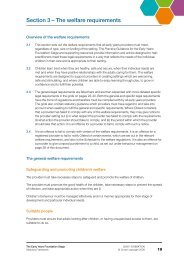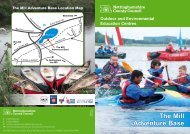Assessing Service Provision in Hotspot Wards across ...
Assessing Service Provision in Hotspot Wards across ...
Assessing Service Provision in Hotspot Wards across ...
You also want an ePaper? Increase the reach of your titles
YUMPU automatically turns print PDFs into web optimized ePapers that Google loves.
County averages. Smaller than average <strong>in</strong>equality gaps for schools that servehotspot wards suggest that parental <strong>in</strong>come does not necessarily predeterm<strong>in</strong>e<strong>in</strong>equalities <strong>in</strong> atta<strong>in</strong>ment and that school catchments areas reach wider than childpoverty hot spot wards. Furthermore the existence of large fluctuations <strong>in</strong>achievement gaps between schools suggest that school management is crucial <strong>in</strong>help<strong>in</strong>g to determ<strong>in</strong>e outcomes for pupils.Head TeachersMany head teachers expressed the notion that they and their staff do not feelconfident address<strong>in</strong>g issues of child and family poverty. Whilst the primary concern ofschools is educational atta<strong>in</strong>ment, help<strong>in</strong>g to improve a child’s well-be<strong>in</strong>g positivelyimpacts upon achievement and so it is recommended that these f<strong>in</strong>d<strong>in</strong>gs be exploredfurther. In the immediate future it is suggested that a child and family povertyresource be developed to better conceptualise poverty for schools and l<strong>in</strong>k povertyissues to exist<strong>in</strong>g services.Rais<strong>in</strong>g the aspirations of children and receiv<strong>in</strong>g support to help achieve this wasalso a prom<strong>in</strong>ent theme to emerge. Rais<strong>in</strong>g aspiration is a crucial aspect ofNott<strong>in</strong>ghamshire’s Child and Family Poverty Strategy, and a pledge byNott<strong>in</strong>ghamshire County Council states: ‘We will build the aspirations of children andfamilies’. Therefore, support to schools based on this commitment is an importantconsideration.Extended <strong>Service</strong>sThe unique position that Extended <strong>Service</strong>s occupy, means that they perform an<strong>in</strong>valuable role <strong>in</strong> reduc<strong>in</strong>g child and family poverty. The close work<strong>in</strong>g relationshipthat co-ord<strong>in</strong>ators are expected to have with teachers allows them to identify childrenthat require additional help to build a suite of activities to support these children and,critically, <strong>in</strong>volve the parents whenever possible.An important challenge is to avoid stigmatism of free school meals (FSM) childrenand their families through identify<strong>in</strong>g them for extra support. A comb<strong>in</strong>ation ofuniversal support and carefully targeted activities could serve to mitigate thisproblem.The performance management of Extended <strong>Service</strong>s should be explored further toenable them to improve evidence of their impact and to assist <strong>in</strong> plann<strong>in</strong>g futureresource allocations. The nature of the fund<strong>in</strong>g arrangements will provide challengesto comprehensively implement a standardised performance model. However if coord<strong>in</strong>atorsand schools can contribute to and agree a process, then effective datacollection becomes more likely.Targeted Support and Youth Justice <strong>Service</strong>Information from this service gives an <strong>in</strong>dication as to where children and youngpeople require more <strong>in</strong>tensive support to deal with serious problems. Reduction ofchild and family poverty implies a much more preventative approach to improv<strong>in</strong>g thelives of children and their families. Therefore, if certa<strong>in</strong> areas can be identified, suchas Worksop South East, that have high numbers of children experienc<strong>in</strong>g problems <strong>in</strong>their lives, then more proactive and preventative services can be better targeted,<strong>in</strong>clud<strong>in</strong>g children’s centre provision, Extended <strong>Service</strong>s and employability tra<strong>in</strong><strong>in</strong>g.These services have recently started collect<strong>in</strong>g data at ward level, which will allowdetailed mapp<strong>in</strong>g of localities that experience particular problems for children andyoung people.3
Employment and SkillsAdult and Community Learn<strong>in</strong>g <strong>Service</strong> (ACLS)Based on <strong>in</strong>formation from hot spot wards, the majority of fund<strong>in</strong>g is not spent oncourses dedicated to employability skills due to current fund<strong>in</strong>g arrangements notbe<strong>in</strong>g aligned for this purpose. Employability skills courses compliment the Personaland Community Development Fund (PCDL) and family learn<strong>in</strong>g courses to helpcreate a more holistic learn<strong>in</strong>g pathway. The robust commission<strong>in</strong>g processes andthe current provision of PCDL and family learn<strong>in</strong>g courses imply that ACLS are wellplaced to deliver courses around employability more extensively.Furthermore, family learn<strong>in</strong>g has an important role <strong>in</strong> reduc<strong>in</strong>g child and familypoverty. Therefore, partnership work with schools and related extended servicescoord<strong>in</strong>ators is <strong>in</strong>valuable and should cont<strong>in</strong>ue to be developed and improved.Currently no resident from any of the priority wards has attended a course run <strong>in</strong>partnership with extended services as def<strong>in</strong>ed with<strong>in</strong> ACLS’s attendance data.Although the Family Learn<strong>in</strong>g Impact Fund and wider Family Learn<strong>in</strong>g fund<strong>in</strong>gstreams do require co-operation from head teachers and Extended <strong>Service</strong>s, thisdoes suggest that there is further collaboration to be established between Extended<strong>Service</strong>s and ACLS.ACLS also comments that it experiences occasional rigidity from head teachers thataffects extended services co-operation and can prevent courses be<strong>in</strong>g delivered onschool sites. An appreciation of the family context and the role ACLS plays is crucialto support<strong>in</strong>g cohesive families, build<strong>in</strong>g aspiration and ensur<strong>in</strong>g a stepp<strong>in</strong>g stone<strong>in</strong>to employment. ACLS <strong>in</strong>volvement may also help to address concerns overaspiration <strong>in</strong> schools raised by head teachers 1 through welcom<strong>in</strong>g parents <strong>in</strong>to alearn<strong>in</strong>g environment and encourag<strong>in</strong>g the <strong>in</strong>volvement of their children.Jobcentre PlusThe lack of capacity with<strong>in</strong> the Jobcentre Plus national performance managementteam has prevented ward level analysis of performance. Importantly though, this typeof analysis is possible through Jobcentre Plus’s data management system.As described, Jobcentre Plus collects important data on clients with children thatallows provision to be tailored to suit the family context. Lone parents are a specificgroup that Jobcentre Plus focuses considerable effort on.The distribution of <strong>in</strong>formation on clients (especially those with children) at ward levelwould serve as an important <strong>in</strong>dicator for several services to best target provision.For example, worklessness can have many knock-on effects for households whichmay demand the <strong>in</strong>volvement of other service areas.The Family Works Initiative was established to engage with hard to reach familiesand support them <strong>in</strong>to employment. The small caseloads and holistic nature of thework meant that advisors could target very vulnerable families. However, suggestedoutcomes do highlight the importance of establish<strong>in</strong>g a visible connection with thecommunities that they serve and build<strong>in</strong>g productive and susta<strong>in</strong>able relationshipswith partner agencies. Holistic approaches rely on multi-agency co-operation, so toreduce child and family poverty, this must be effectively implemented. Projects likethe Family Works Initiative should provide important learn<strong>in</strong>g (not just for JobcentrePlus) regard<strong>in</strong>g partnership approaches to solv<strong>in</strong>g long-stand<strong>in</strong>g problems with<strong>in</strong>communities.1 F<strong>in</strong>d<strong>in</strong>gs from the Child Poverty Workforce Development Survey, August 20114
ConnexionsConnexions currently provides an important advice and guidance service to support16-19 year olds <strong>in</strong>to education, employment or tra<strong>in</strong><strong>in</strong>g. Importantly any futureagency will be required to allocate resources to meet need <strong>across</strong> the City andCounty. There is an <strong>in</strong>dication that Gedl<strong>in</strong>g <strong>in</strong> particular, under the exist<strong>in</strong>g allocation,may not be receiv<strong>in</strong>g appropriate support as a district compared to others.Additionally, it would be useful to observe ward and school level analysis of youngpeople ‘Not <strong>in</strong> Education Tra<strong>in</strong><strong>in</strong>g or Employment’ (NEET) to allow an <strong>in</strong> depth pictureof need.Childcare <strong>Provision</strong>The Childcare Sufficiency Assessment 2011 provides a generally positive picture ofprovision <strong>across</strong> Nott<strong>in</strong>ghamshire. Specific analysis below district level is not<strong>in</strong>cluded <strong>in</strong> the assessment but the Family Information <strong>Service</strong> does provide an<strong>in</strong>dication of availability. All wards are recorded as hav<strong>in</strong>g at least six childcareproviders with<strong>in</strong> close proximity.The common themes centre on the requirement to <strong>in</strong>crease placement numbers as aproportion of the total child population. This is particularly relevant to Bassetlaw,because it was the only district to receive an amber rat<strong>in</strong>g based on placementnumbers. Neither affordability nor quality were identified as underperform<strong>in</strong>g <strong>in</strong> theassessment.Foundation Learn<strong>in</strong>gInformation provided allows an observation on a service that provides courses thatencourages young people <strong>in</strong>to employment or education. The numbers are quitelimited, especially from hotspot wards but it provides an example of preventativeaction that aims to raise aspirations, up-skill young people and improve employmentprospects.F<strong>in</strong>ancial SupportF<strong>in</strong>ancial Inclusion TaskforceThe analysis suggests a strong correlation between child and family poverty andf<strong>in</strong>ancial exclusion. Each district records the most f<strong>in</strong>ancially excluded ward and theward with the highest demand for affordable credit as be<strong>in</strong>g a child and familypoverty hotspot. Furthermore hotspot wards with<strong>in</strong> the reports were consistentlyranked with<strong>in</strong> the top 10% based on f<strong>in</strong>ancial exclusion and demand for credit.The survey highlights that if residents are identified as be<strong>in</strong>g f<strong>in</strong>ancially excluded,then the same area is highly likely to experience high demand for affordable credit.This creates a dilemma whereby residents that require affordable credit are preciselythe residents that are most likely to be f<strong>in</strong>ancially excluded, and so are least likely toreceive affordable credit.This places an emphasis on the provision offered by Citizens Advice Bureaux andCredit Unions. Support<strong>in</strong>g residents from hotspot wards to be f<strong>in</strong>ancially responsibleand provid<strong>in</strong>g affordable l<strong>in</strong>es of credit and sav<strong>in</strong>gs opportunities becomes crucial <strong>in</strong>reduc<strong>in</strong>g levels of f<strong>in</strong>ancial exclusion and therefore reduc<strong>in</strong>g child and family poverty.Citizen’s Advice BureauTak<strong>in</strong>g account of the caveat of recently reduced provision due to fund<strong>in</strong>g reductions,the Citizen’s Advice Bureau (CAB) provides vitally important support for thosefamilies most vulnerable to poverty. Most notably, this is through provid<strong>in</strong>g benefitssupport and guidance on debt and money management.5
<strong>Provision</strong> for hotspots is generally good and engagement with vulnerable groupssuch as workless households, disabled clients and lone parents is encourag<strong>in</strong>g.Work <strong>in</strong> Worksop South East <strong>in</strong> Bassetlaw and Boughton <strong>in</strong> Newark and Sherwoodhas been particularly effective <strong>in</strong> engag<strong>in</strong>g residents, evidenced by high numbers ofclients from vulnerable groups access<strong>in</strong>g the CAB compared to other wards.It is also important to note that the CAB captures important data on clientdemographics and can sort data by ward which has allowed a useful analysis to beconducted. This data can aid the target<strong>in</strong>g of CAB engagement by, for example,identify<strong>in</strong>g areas where few residents access their local CAB.However, <strong>in</strong>formation on Kirkby East <strong>in</strong> Ashfield does suggest that residents <strong>in</strong> thisward are not be<strong>in</strong>g engaged with as much as they should be, consider<strong>in</strong>g the highnumbers of benefits claimants, the high risk of f<strong>in</strong>ancial exclusion and the high levelsof child poverty. Furthermore, engagement <strong>in</strong> Cumberlands over debt managementissues is also quite poor compared to the rest of the district.Credit UnionsThe most notable problem is the lack of coverage of Newark and Sherwood. NeitherNott<strong>in</strong>gham Credit Union nor Two Shires Credit Union <strong>in</strong>cludes this district with<strong>in</strong>their catchment area. This clear gap <strong>in</strong> provision needs to be addressed to ensureaccess to affordable credit and money management support.The recent <strong>in</strong>corporation of Ashfield and Mansfield with<strong>in</strong> Nott<strong>in</strong>gham Credit Union’sremit represents an important challenge <strong>in</strong> provid<strong>in</strong>g comprehensive and accessibleprovision. Currently Ashfield observes a low number of members compared toGedl<strong>in</strong>g and Mansfield and it is suggested that engagement with residents,particularly from Kirkby East, be implemented to improve membership rates.The l<strong>in</strong>k between poverty and f<strong>in</strong>ancial support is aga<strong>in</strong> evidenced by the highnumbers of clients <strong>in</strong> Worksop South East tak<strong>in</strong>g loans out with the Two ShiresCredit Union. Furthermore the high number of households with dependants, <strong>in</strong>particular lone parents that access the Union highlights the importance of provision tofamilies that are more likely to suffer from poverty.Place and DeliveryLocalism and PartnershipsThe newly created Localism and Partnerships Team is well placed to champion thechild and family poverty agenda with<strong>in</strong> local communities, voluntary organisationsand relevant partnerships. A holistic approach is vital to address poverty, so rais<strong>in</strong>gawareness and mak<strong>in</strong>g clear l<strong>in</strong>ks with service areas provides a basis for action.District CouncilsDistrict councils all contribute to the child and family poverty agenda with examples of<strong>in</strong>itiatives and good practice. Hous<strong>in</strong>g data was unavailable for this report 2 but itrepresents an area for future work as there are strong l<strong>in</strong>ks between social hous<strong>in</strong>gtenancy and poverty.The Killisick Improvement Team represents an example of collaborative work<strong>in</strong>g leadby Gedl<strong>in</strong>g District Council that attempts to holistically tackle problems <strong>in</strong> areas ofhigh deprivation. The local experience and knowledge that district councils can2 Hous<strong>in</strong>g Data was not identified because of limited capacity by the researcher.6
provide when co-ord<strong>in</strong>at<strong>in</strong>g efforts such as this means they are well placed to lead on<strong>in</strong>itiatives to tackle child and family poverty at a local level. The identification ofpoverty hotspots may provide an <strong>in</strong>itial focus for authorities.Common Assessment Framework (CAF) and Jo<strong>in</strong>t Access Teams (JAT)Ward level analysis highlights considerable variations <strong>in</strong> CAF <strong>in</strong>itiations, for exampleKirkby <strong>in</strong> Ashfield East and Worksop South East both display high numbers of activeCAFs. These results could serve to focus the attention of services to best reflect thespecific dynamics with<strong>in</strong> an area.This analysis also can expose whether there is potential for under-representationfrom certa<strong>in</strong> areas based on active CAFs. If an area with high poverty levels, poorIndex of Multiple Deprivation scores and low educational atta<strong>in</strong>ment, records muchlower than average active CAFs, then it may suggest that children requir<strong>in</strong>g help arego<strong>in</strong>g unnoticed. Furthermore, if this is cross referenced aga<strong>in</strong>st organisations thatare <strong>in</strong>itiat<strong>in</strong>g CAFs, it may provide further <strong>in</strong>sight <strong>in</strong>to the engagement of services andthe consistency of CAF <strong>in</strong>itiations <strong>across</strong> JATs.RECOMMENDATIONSFamily and Life Chances1. Children’s centres could assign particular attention to the development ofservices that encourage and support economic susta<strong>in</strong>ability for families:a. Retention and cont<strong>in</strong>ued development of Jobcentre Plus outreachb. Engagement with the creation of work clubs and the use of children’scentre sites to host clubs.2. Improved engagement with the focus population by children’s centres:a. Distribution of the relative child poverty measure to all children’s centresb. Use IDACI and relative child poverty data to effectively target proactiveengagement with<strong>in</strong> the communityc. Proactive engagement and monitor<strong>in</strong>g of groups with children at greatestrisk of poverty, <strong>in</strong>clud<strong>in</strong>g teenage parents, disabled parents and s<strong>in</strong>gleparents.3. Child Poverty Reference Group to consider the production of a child and familypoverty resource document to be distributed to schools and other sett<strong>in</strong>gs e.g.youth and play services.4. Children, Families and Cultural <strong>Service</strong>s to establish a comprehensive approachto rais<strong>in</strong>g aspirations. An <strong>in</strong>itial th<strong>in</strong>k tank session with attendance from children’scentres, schools, youth services and social services to explore the issue andagree an action plan is suggested.5. Child poverty activity should be <strong>in</strong>cluded <strong>in</strong> the forthcom<strong>in</strong>g ‘Clos<strong>in</strong>g the Gap’strategy for education.6. Schools could make the most of the forthcom<strong>in</strong>g pupil premium which will beallocated based on levels of deprivation us<strong>in</strong>g free school meal (FSM) data. TheDepartment for Education recommends that pupil premium budget (which will notbe r<strong>in</strong>g fenced) is allocated <strong>in</strong> each school to improve atta<strong>in</strong>ment of the poorestpupils.7
7. It is advisable that schools and the Governor Unit identify a named championgovernor <strong>in</strong> each school to support the school to fulfil its responsibilities toimprove outcomes for the most disadvantaged children and young people.8. Extended <strong>Service</strong>s to ensure activities and support <strong>in</strong>cludes parental <strong>in</strong>volvementat every possible opportunity to encourage susta<strong>in</strong>able family development.9. Extended <strong>Service</strong>s to explore a comprehensive performance managementprocedure to better evidence impact and allow a comparison of performancebetween families of schools.10. The Child Poverty Reference Group could utilise ward level Targeted Supportand Youth Justice <strong>Service</strong>s data to better understand the distribution of youngpeople that are fall<strong>in</strong>g <strong>in</strong>to difficulties.Employment and Skills11. ACLS could expand the provision of employability skills courses to establish aholistic learn<strong>in</strong>g pathway.12. Increased partnership work between schools and ACLS to effectively <strong>in</strong>tegratefamily learn<strong>in</strong>g.13. Jobcentre Plus could provide ward level data as part of the <strong>in</strong>formation shar<strong>in</strong>gwith the County Council and its partners.14. Child Poverty Reference Group may perhaps identify key learn<strong>in</strong>g from holisticprojects like the Family Works Initiative to establish collaborative ways toeffectively tackle child and family poverty.15. Children, Families and Cultural <strong>Service</strong>s to commit to the recommendationswith<strong>in</strong> the Childcare Sufficiency Assessment 2011 by <strong>in</strong>creas<strong>in</strong>g childcareplacement numbers especially <strong>in</strong> Bassetlaw.16. Child Poverty Reference Group to ma<strong>in</strong>ta<strong>in</strong> a 16-19 NEET focus and activelyengage with agencies tasked with support<strong>in</strong>g young people <strong>in</strong>to further education,employment or tra<strong>in</strong><strong>in</strong>g.17. Future agencies engag<strong>in</strong>g with 16-19 year olds must review and target resourcesto ensure the most vulnerable young people are receiv<strong>in</strong>g adequate support.F<strong>in</strong>ancial Support18. The CAB and their commissioners could further explore and analyse CAB data toga<strong>in</strong> a better understand<strong>in</strong>g of local need and plan accord<strong>in</strong>gly.19. Newark and Sherwood District must be appropriately served by a credit unioneither through the establishment of a new union or through the expansion of anexist<strong>in</strong>g credit union.20. There should be better promotion of the changes with<strong>in</strong> local credit unions whichtarget at risk groups and localities.21. Child Poverty Reference Group to further explore the l<strong>in</strong>ks between f<strong>in</strong>ancialexclusion and child and family poverty to establish the significance of provid<strong>in</strong>gf<strong>in</strong>ancial support and guidance <strong>in</strong> reduc<strong>in</strong>g poverty.22. A greater understand<strong>in</strong>g of debt issues for families with<strong>in</strong> Nott<strong>in</strong>ghamshire wouldbe beneficial to prevent debt and f<strong>in</strong>ancial exclusion. Greater l<strong>in</strong>ks with Experiancould be developed to make use of their data.8
Place and Delivery23. Nott<strong>in</strong>ghamshire County Council’s Localism and Partnerships Team couldchampion the reduction of child and family poverty.24. Children, Families and Cultural <strong>Service</strong>s are advised to <strong>in</strong>clude a ward levelanalysis on active CAFs with<strong>in</strong> report<strong>in</strong>g cycles to <strong>in</strong>form service delivery.25. District councils could review the availability of hous<strong>in</strong>g data and homelessness,especially at ward level.26. District council child poverty leads could use the child poverty agenda to shareemerg<strong>in</strong>g practice and work together on particular <strong>in</strong>itiatives.27. District Councils could explore methods of coord<strong>in</strong>at<strong>in</strong>g support <strong>in</strong> specific areasof advantage, draw<strong>in</strong>g upon examples of good practice such as the KillisickImprovement Team.Suggested Next StepsIn addition to the recommendations already listed, the Child Poverty ReferenceGroup is asked to also consider the follow<strong>in</strong>g suggestions to aid improved data andresearch for child poverty hot spot wards:28. The locations of key services with<strong>in</strong> each target hot spot ward could be plottedonto LSOA child poverty maps to highlight their location <strong>in</strong> relation to targetgroups. Maps have been <strong>in</strong>cluded <strong>in</strong> the appendix of this exec summary and thema<strong>in</strong> report which contribute to this recommendation.29. A more simplified version of this exercise could be completed for additional hotspot wards as def<strong>in</strong>ed by the 2009 child poverty data published on the 30 thSeptember 2011.30. Nott<strong>in</strong>ghamshire County Council and partners could target their resources and<strong>in</strong>terventions to very specific areas and demographic groups us<strong>in</strong>g LSOA data asappropriate.31. <strong>Assess<strong>in</strong>g</strong> whether key target groups are access<strong>in</strong>g services and subsequentlyevaluat<strong>in</strong>g the effectiveness of the support should be a key driver for theperformance of a number of services for example the numbers of disabledparents and teenage parents access<strong>in</strong>g Children Centres and the outcomes forthem.32. Key f<strong>in</strong>d<strong>in</strong>gs from this report could be shared with District Children and FamilyPartnership groups to enable them to adopt similar exercises, as well as be<strong>in</strong>gequipped with the knowledge of service gaps, good practice and awareness ofwhich localities and groups to actively target.9
APPENDIX ONEKey services serv<strong>in</strong>g Hot Spot <strong>Wards</strong>ASHFIELD10
BASSETLAW11
GEDLING12
MANSFIELD13
NEWARK AND SHERWOOD14












![Every Parent Matters [PDF 463KB] - Nottinghamshire County Council](https://img.yumpu.com/47250686/1/184x260/every-parent-matters-pdf-463kb-nottinghamshire-county-council.jpg?quality=85)


![School Employee Domestic Violence and Abuse Policy [PDF 228KB]](https://img.yumpu.com/46294446/1/184x260/school-employee-domestic-violence-and-abuse-policy-pdf-228kb.jpg?quality=85)
